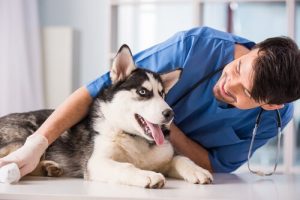Canine Parvovirus


Written and verified by the lawyer Francisco María García
Canine parvovirus is one of the most common diseases in recent decades. Though humans cannot catch it, it is highly contagious between dogs, and the mortality rate is concerning.
The spread of parvovirus is linked to dogs being abandoned in unhealthy environments.
The uncontrolled breeding of these dogs, means that puppies born in the street are especially vulnerable. In turn, the risk of the disease spreading increases.
If you are going to adopt a dog, you need to take them for deworming and follow the vaccination schedule. Prevention is the most effective way to look after your friend.
What is Canine Parvovirus?
Canine Parvovirus is an acute viral infection. It affects the gastrointestinal tract, blood, and red blood cells. In rarer cases, it can affect muscle cells (mainly in puppies).

It was officially identified during the 1970s and is considered to be a very recent disease.
The microorganism is very resistant and can survive in hostile environments. It can lie dormant for a long time before becoming active again.
Using common disinfectants, chlorine, or corrosive products does not seem to be effective in getting rid of it from the home.
As a result, it is really common for parvovirus to contaminate various items around the home. It may contaminate food, food storage, blankets, bedding, or kennels. Before leaving your dog in any establishment, you need to reassure yourself. Make sure it complies with sanitation rules and has the relevant vaccination certificates.
Incidence in Puppies
This virus has continued to spread and now has an almost universal reach. It is a concern to veterinary professionals on every continent. It can affect dogs of all ages, breeds, and sizes. However, it is more common in puppies.
A puppy’s body is more vulnerable and easy to infect. Their immune system has still not fully developed to deal with numerous microorganisms in their environment. Furthermore, intense cellular activity during their growth phase will make it easier for the virus to replicate.
The comparison of diagnosed cases in adult dogs and puppies, suggests that some breeds are more at risk than others. Such breeds include the Labrador Retriever, Rottweiler, and the Doberman.
Canine parvovirus is particularly alarming because of the low survival rates and the repetition of the viral load.
If not treated within the first 36 hours, the infection can cause death within just a few days. As a result, it is crucial that you take your dog to the vet as soon as you notice any change in their routine or behaviour.
What are the Symptoms of Canine Parvovirus?
As we have mentioned, the replication of parvovirus in the body is very intense. It normally causes an accelerated and general decline in health.
Infected dogs tend to rapidly show the following signs:
- Loss of appetite.
- Fatigue, lethargy, and/or drowsiness.
- Fever.
- Dehydration.
- Vomiting.
- Severe diarrhoea that can contain blood.
The majority of deaths occur between 48 and 72-hours after symptoms appear.
Therefore, we stress again that you need to go straight to a vet if you see any such change in your dog.
How is Canine Parvovirus Spread?
This virus is transmitted directly, commonly via a faecal-oral route. It mainly affects animals that tend to eat either their own or other animals’ faeces (coprophagia).
However, parvovirus is highly resilient and can lie dormant on various surfaces. This increases the number of ways a dog can become infected. They could come into contact with the virus through an infected object or by rubbing themselves on a contaminated surface.
Is There Any Treatment for Canine Parvovirus?
There is no specific medication for getting rid of canine parvovirus. Treatment involves strengthening the immune system to help beat the infection.
Therefore, prevention and early diagnosis is key when it comes to this disease.

How to Prevent Canine Parvovirus?
Being a responsible owner is the best form of prevention. Follow a vaccination schedule and regularly deworm dogs from the beginning.
Maintaining a balanced diet and regular physical exercise are essential for a dog’s healthy development.
Canine parvovirus is one of the most common diseases in recent decades. Though humans cannot catch it, it is highly contagious between dogs, and the mortality rate is concerning.
The spread of parvovirus is linked to dogs being abandoned in unhealthy environments.
The uncontrolled breeding of these dogs, means that puppies born in the street are especially vulnerable. In turn, the risk of the disease spreading increases.
If you are going to adopt a dog, you need to take them for deworming and follow the vaccination schedule. Prevention is the most effective way to look after your friend.
What is Canine Parvovirus?
Canine Parvovirus is an acute viral infection. It affects the gastrointestinal tract, blood, and red blood cells. In rarer cases, it can affect muscle cells (mainly in puppies).

It was officially identified during the 1970s and is considered to be a very recent disease.
The microorganism is very resistant and can survive in hostile environments. It can lie dormant for a long time before becoming active again.
Using common disinfectants, chlorine, or corrosive products does not seem to be effective in getting rid of it from the home.
As a result, it is really common for parvovirus to contaminate various items around the home. It may contaminate food, food storage, blankets, bedding, or kennels. Before leaving your dog in any establishment, you need to reassure yourself. Make sure it complies with sanitation rules and has the relevant vaccination certificates.
Incidence in Puppies
This virus has continued to spread and now has an almost universal reach. It is a concern to veterinary professionals on every continent. It can affect dogs of all ages, breeds, and sizes. However, it is more common in puppies.
A puppy’s body is more vulnerable and easy to infect. Their immune system has still not fully developed to deal with numerous microorganisms in their environment. Furthermore, intense cellular activity during their growth phase will make it easier for the virus to replicate.
The comparison of diagnosed cases in adult dogs and puppies, suggests that some breeds are more at risk than others. Such breeds include the Labrador Retriever, Rottweiler, and the Doberman.
Canine parvovirus is particularly alarming because of the low survival rates and the repetition of the viral load.
If not treated within the first 36 hours, the infection can cause death within just a few days. As a result, it is crucial that you take your dog to the vet as soon as you notice any change in their routine or behaviour.
What are the Symptoms of Canine Parvovirus?
As we have mentioned, the replication of parvovirus in the body is very intense. It normally causes an accelerated and general decline in health.
Infected dogs tend to rapidly show the following signs:
- Loss of appetite.
- Fatigue, lethargy, and/or drowsiness.
- Fever.
- Dehydration.
- Vomiting.
- Severe diarrhoea that can contain blood.
The majority of deaths occur between 48 and 72-hours after symptoms appear.
Therefore, we stress again that you need to go straight to a vet if you see any such change in your dog.
How is Canine Parvovirus Spread?
This virus is transmitted directly, commonly via a faecal-oral route. It mainly affects animals that tend to eat either their own or other animals’ faeces (coprophagia).
However, parvovirus is highly resilient and can lie dormant on various surfaces. This increases the number of ways a dog can become infected. They could come into contact with the virus through an infected object or by rubbing themselves on a contaminated surface.
Is There Any Treatment for Canine Parvovirus?
There is no specific medication for getting rid of canine parvovirus. Treatment involves strengthening the immune system to help beat the infection.
Therefore, prevention and early diagnosis is key when it comes to this disease.

How to Prevent Canine Parvovirus?
Being a responsible owner is the best form of prevention. Follow a vaccination schedule and regularly deworm dogs from the beginning.
Maintaining a balanced diet and regular physical exercise are essential for a dog’s healthy development.
This text is provided for informational purposes only and does not replace consultation with a professional. If in doubt, consult your specialist.








